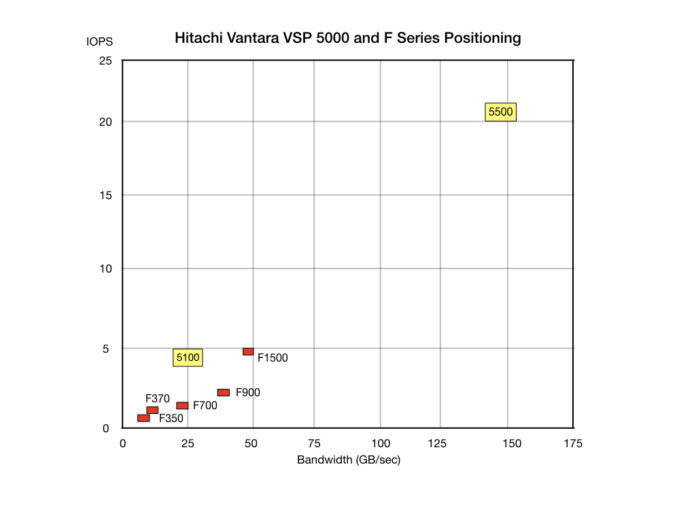Hitachi Vantara has beefed up its high-end storage line-up with the VSP 5000 series, which it claims is the world’s fastest enterprise array.
The company can certainly claim bragging rights in IOPS terms but others perform better on latency and bandwidth.
The obvious comparison is with Dell EMC’s PowerMax which has a higher latency (sub-200μs), is slower and has lower capacity limits.
PowerMax 2000 has up to 2.7m random read IOPS and 1PB effective capacity. The VSP 5100 exceeds both, with 4.2m IOPS and 23PB of capacity.
PowerMax 8000 offers up to 15m IOPS, 350GB/sec and 4PB effective capacity. The VSP 5500 has up to 21m IOPS, 148GB/sec and 69PB capacity, making it slower on bandwidth but better in the other categories
Infinidat’s Infinibox array handle 32μs for reads and 38μs for writes. This is lower than the VSP 5000s 70μs. Also Infinibox has up to 1.3m IOPS and 15.2GB/sec throughput, giving it lower performance than the VSP 5100 (4.2m IOPS and 25GB/sec) and much lower than the VSP 5500 (21m IOPS and 149GB/sec).
Speccing out the VSP 5000
Hitachi Vantara’s 5000s have much higher capacity than the existing VSP F all-flash and G hybrid Series. They are designed to accelerate and consolidate transactional systems, containerised applications, analytics and mainframe storage workloads, so as to reduce data centre floor space and costs.
Two all-flash 5000 Series arrays – the 5100 and 5500 – provide block and file access storage. They have hybrid flash+disk variants – the 5100H and 5500H – and use an ‘Accelerated Fabric’ for internal connectivity between controllers and drives. Minimum latency is 70μs.

Claimed performance is 42m IOPS for the 5100 and 5100H, and 21m for the 5500 and 5500H arrays.
The F Series uses SAS commodity SSDs with up to 15TB capacity, or Hitachi’s proprietary Flash Module Drives (FMDs) with a maximum 14TB. NVMe SSDs are introduced with the 5000 Series, ranging up to 30TB in capacity. SAS SSDs and FMDs are also available.
The hybrid variants can use 2.4TB, 10,000rpm, 2.5-inch disk drives or 14TB, 7,200rpm, 3.5-inch disks.
The internal raw capacity limits for the 500 and 5100H are 23PB. It is 69PB for the 5500 and 5500H. External capacity limits are 287PB for all 5000s.
The 5100s have a single controller block with two controllers and 4 acceleration modules for the internal fabric. The 5500s have 1, 2 or 3 controller blocks, with 4 controllers and 8 acceleration modules per block. These use FPGAs and link to a central fabric infrastructure switch.
The FPGAs offload IO work from the controllers. The fabric uses direct memory access which, in tandem with the FPGAs, enables the high IOPS performance. Read a Hitachi Accelerated Fabric white paper here.

The fabric is based on PCIe Gen 3 x4 lanes and is built with quadruple redundancy to deliver 99.999999 per cent availability, Hitachi Vantara claims. It allows tiering of data across controller blocks for improved price-performance.
Host interfaces supported are 16 and 32Gbits/sec Fibre Channel, 16Gbit/s FICON for mainframes, and 10Gbit/s iSCSI.
The 5000s can be upgraded to use NVMe over Fabrics and storage-class memory (Optane.) They are not supported yet. (PowerMax is shipping both.)
Deduplication
The 5000s have up to 7:1 data reduction ratio with deduplication and compression. The deduplication method uses machine learning models to optimise deduplication block size and use either in-line or post-process dedupe to get as much deduplication as possible while reducing the performance impact of dedupe processing.
Up to 5.5:1 data reduction is achievable without measurable reduction in system performance, Hitachi said.
We can position the VSP 5000 and F series in a 2D IOPS x bandwidth chart:

This indicates how the existing VSP F1500 (4.8m IOPS, 48GB/sec) is faster than the 5100 (4.2m IOPS, 25GB/sec.) The 5500 is, of course, vastly more powerful than the F1500.
Existing VSP systems can be virtualized by the 5000 series – a property of the SVOS software, and become resources for the 5000s.
A VSP Cloud Connect Pack adds an HNAS 4000 file storage gateway to the system. It moves data to a public cloud to free up capacity. The moved data is made indexable and searchable.
There is a 100 per cent availability guarantee. Hitachi’s Global-Active Device (GAD) delivers synchronous clustering of applications between VSP 5000 sites that are up to 500 kilometres apart.
SVOS and Ops Center
Hitachi Vantara today also introduced Ops Center – infrastructure management software that uses AI to automate data centre management tasks
The Storage Virtualization Operating System (SVOS) RF 9 offers scale-out architecture and supports NVMe over Fabrics and Optane drives. Hitachi Vantara said the software incorporate “AI intelligence that adapts to changing conditions to optimise any workload performance, reduce storage costs and predict faults that could disrupt operations.”
The system has NVMe flash, SAS flash and disk drive storage classes. AI techniques and machine learning are used to dynamically promote and demote data to an optimized tier to accelerate applications.
Hitachi says Ops Center can automate up to 70 per cent of data centre workloads and provides “faster, more accurate insights to diagnose system health” and keep operations running.
HPE has announced its HPE XP8 Storage system; it OEMs Hitachi’sVSP arrays under the XP8 brand.
Hitachi Virtual Storage Platform (VSP) 5000 series, Hitachi Ops Center and SVOS RF 9 are available now.








